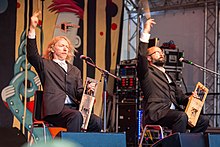20:
90:
212:
394:
175:
Talharpas were traditionally built by hollowing out a single block of wood and gluing a soundboard on top, as can be seen from many instruments stored in the museums in
Estonia and Finland. In modern times, many talharpa makers continue to build their musical instruments from solid wood, such as
66:
who came to
Estonia around the 10th century from the Swedish part of Finland; they likely brought the instrument with them (later Swedish settlers in Estonia did not know nor use the talharpa.) It is similar to the Finnish
58:
from northern Europe. It is questionable whether it was formerly common and widespread in
Scandinavia. Historically, it has been played in the Estonian-Swedish areas and in Western
149:-like instrument, dating to around the 14th century. In Nordic countries, the bowed lyre (as opposed to the plucked harp) has continued in Finland, where it is called
200:. Other notable musicians and bands, that use a bowed-lyre family instruments: Sofia Joons, Strand...Rand, Pekko Käppi, Styrbjörn Bergelt, Krista Sildoja,
180:, with each part assembled and characterized by reinforcements, bands, counter-bands, figured bottoms and blocks (such as Raivo Sildoja).
428:
355:
325:
Andersson, Otto (1930). The Bowed Harp. Translated and edited by
Kathleen Schlesinger. London: New Temple Press p. 111
310:
283:
137:-like instrument (also don't include a bow and instrument is in a very different shape) and a stone carving at the
176:
Rait Pihlap, Mihkel Soon or Rauno
Nieminen. Others began to make tagelharpas following the classical school of
86:
probably comes from a dialectical form of the word "tagel" – horsehair – from which the strings were made.
19:
398:
89:
254:
345:
300:
211:
433:
119:, though not as a bowed instrument. There have been attempts to interpret as talharpa the
8:
138:
44:
351:
306:
279:
188:
The talharpa is sometimes used in modern folk music, most notably by the
Estonian
63:
246:
240:
128:
405:
422:
197:
115:
201:
146:
142:
120:
278:. Vol. 1 (2nd ed.). London: Rough Guides Limited. p. 18.
111:
230:
205:
177:
68:
410:
193:
189:
124:
93:
An
Estonian man playing the hiiu kannel (or, talharpa), ca. 1920.
76:
59:
23:
Talharpa, by
Charlie Bynum, Silver Spoon Music, Alkmaar NL, 2014
393:
274:
Cronshaw, Andrew (1999). "Baltic States: singing revolutions".
43:(which meant Vormsi island located on the halfway to Hiiumaa)
377:
225:
72:
52:
75:. Jouhikko, a close relative of talharpa, is still known in
107:
103:
55:
235:
141:of Norway, that shows a musician playing a bowed
420:
102:The earliest known Norse literary mentions of a
406:"Per Runberg demonstrates playing the talharpa"
347:The Garland Encyclopedia of World Music: Europe
302:Origins and Development of Musical Instruments
162:
156:
150:
132:
334:Nieminen, Rauno (2020) The Bowed Lyre. p.16
170:
273:
210:
88:
51:(bowed harp), is a two to four stringed
18:
298:
421:
343:
13:
14:
445:
386:
392:
161:and Estonia where it is called
371:
337:
328:
319:
292:
276:The Rough Guide to World Music
267:
1:
260:
196:who use talharpas and modern
183:
97:
429:Estonian musical instruments
208:, Per Runberg, Janne Mängli
7:
219:
127:charming the snakes in the
10:
450:
379:, Puuluup official website
350:. Routledge. p. 730.
305:. Scarecrow. p. 174.
299:Montagu, Jeremy (2007).
255:Bowed string instrument
171:Construction techniques
344:Rice, Timothy (2017).
216:
163:
157:
151:
133:
94:
24:
214:
92:
62:, particularly among
22:
401:at Wikimedia Commons
139:Trondheim Cathedral
217:
95:
35:(tail-hair harp),
31:, also known as a
25:
397:Media related to
16:String instrument
441:
415:
396:
380:
375:
369:
368:
366:
364:
341:
335:
332:
326:
323:
317:
316:
296:
290:
289:
271:
251:
215:Puuluup on stage
166:
160:
154:
136:
449:
448:
444:
443:
442:
440:
439:
438:
419:
418:
404:
389:
384:
383:
376:
372:
362:
360:
358:
342:
338:
333:
329:
324:
320:
313:
297:
293:
286:
272:
268:
263:
249:
222:
186:
173:
100:
64:Estonian Swedes
17:
12:
11:
5:
447:
437:
436:
431:
417:
416:
402:
388:
387:External links
385:
382:
381:
370:
357:978-1351544269
356:
336:
327:
318:
311:
291:
284:
265:
264:
262:
259:
258:
257:
252:
244:
241:Byzantine lyra
238:
233:
228:
221:
218:
185:
182:
172:
169:
99:
96:
71:and the Welsh
15:
9:
6:
4:
3:
2:
446:
435:
432:
430:
427:
426:
424:
413:
412:
407:
403:
400:
395:
391:
390:
378:
374:
359:
353:
349:
348:
340:
331:
322:
314:
312:9780810877702
308:
304:
303:
295:
287:
285:1-85828-635-2
281:
277:
270:
266:
256:
253:
250:(in Estonian)
248:
245:
242:
239:
237:
234:
232:
229:
227:
224:
223:
213:
209:
207:
203:
199:
195:
191:
181:
179:
168:
165:
159:
153:
148:
144:
140:
135:
130:
126:
122:
118:
117:
113:
109:
105:
91:
87:
85:
80:
78:
74:
70:
65:
61:
57:
54:
50:
46:
42:
38:
34:
30:
21:
409:
373:
361:. Retrieved
346:
339:
330:
321:
301:
294:
275:
269:
243:(bowed lyre)
198:live looping
187:
174:
158:jouhikantele
123:, that show
114:
110:date to the
101:
83:
81:
48:
40:
39:(originally
36:
32:
28:
26:
434:Bowed lyres
247:Hiiu kannel
164:hiiu kannel
147:nyckelharpa
143:hurdy gurdy
121:iconography
37:hiiu kannel
423:Categories
261:References
184:Modern use
112:Eddic poem
98:Background
49:stråkharpa
41:hiiurootsi
33:tagelharpa
363:13 August
202:Metsatöll
129:snake pit
82:The name
399:Talharpa
231:Jouhikko
220:See also
206:Wardruna
178:lutherie
152:jouhikko
84:talharpa
69:jouhikko
29:talharpa
411:YouTube
194:Puuluup
190:nu-folk
131:with a
116:Völuspá
77:Finland
60:Estonia
354:
309:
282:
125:Gunnar
45:kannel
226:Crwth
155:or a
145:- or
134:harpa
73:crwth
53:bowed
47:) or
365:2019
352:ISBN
307:ISBN
280:ISBN
192:duo
108:lyre
104:harp
56:lyre
27:The
236:Gue
106:or
425::
408:.
204:,
167:.
79:.
414:.
367:.
315:.
288:.
Text is available under the Creative Commons Attribution-ShareAlike License. Additional terms may apply.





